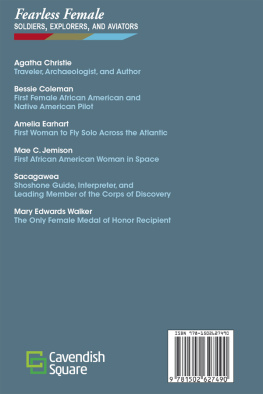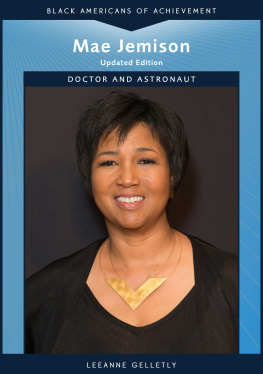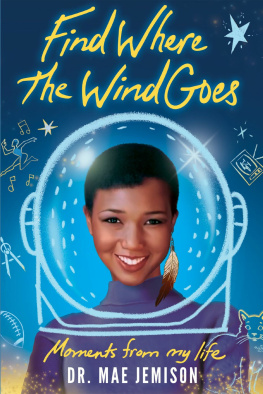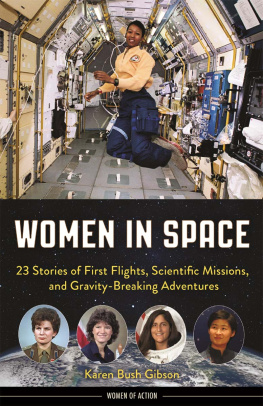Inhalt
Mae C. Jemison : first African American woman in space

Published in 2018 by Cavendish Square Publishing, LLC
243 5th Avenue, Suite 136, New York, NY 10016
Copyright 2018 by Cavendish Square Publishing, LLC
First Edition
No part of this publication may be reproduced, stored in a retrieval system, or transmitted in any form or by any meanselectronic, mechanical, photocopying, recording, or otherwisewithout the prior permission of the copyright owner. Request for permission should be addressed to Permissions, Cavendish Square Publishing, 243 5th Avenue, Suite 136, New York, NY 10016. Tel (877) 980-4450; fax (877) 980-4454.
Website: cavendishsq.com
This publication represents the opinions and views of the author based on his or her personal experience, knowledge, and research. The information in this book serves as a general guide only. The author and publisher have used their best efforts in preparing this book and disclaim liability rising directly or indirectly from the use and application of this book.
CPSIA Compliance Information: Batch #CS17CSQ
All websites were available and accurate when this book was sent to press.
Library of Congress Cataloging-in-Publication Data
Names: Thiel, Kristin, 1977- author.
Title: Mae C. Jemison : first African American woman in space / Kristin Thiel. Description: New York : Cavendish Square Publishing, [2018] |
Series: Fearless female soldiers, explorers, and aviators |
Includes bibliographical references and index.
Identifiers: LCCN 2017003657 (print) | LCCN 2017006421 (ebook) |
ISBN 9781502627513 (library bound) | ISBN 9781502627520 (E-book)
Subjects: LCSH: Jemison, Mae, 1956--Juvenile literature. |
African American women astronauts--Biography--Juvenile literature. | Astronauts--United States--Biography--Juvenile literature.
Classification: LCC TL789.85.J46 T47 2018 (print) | LCC TL789.85.J46 (ebook) | DDC 629.450092 [B] --dc23 LC record available at https://lccn.loc.gov/2017003657
Editorial Director: David McNamara
Editor: Stacy Orlando
Copy Editor: Nathan Heidelberger
Associate Art Director: Amy Greenan
Designer: Stephanie Flecha
Production Coordinator: Karol Szymczuk
Photo Research: J8 Media
The photographs in this book are used by permission and through the courtesy of: Cover JSC.NASA/Wikimedia Commons/File:Mae Jemison in Space.jpg/CCO; p. NASA.
Printed in the United States of America
Contents

A 1992 NASA photo of Jemison, taken before she became the first African American woman in space
one
Jemison s Corner oftheUniverse
Dont let anyone rob you of your imagination, your creativity, or your curiosity. Its your place in the world; its your life. Mae C. Jemison

I n 1992, starry canvas, and crew member Jemison became the first African American woman in space.
Her ship, the Endeavour, was named for an eighteenth-century ship that was one of the first to ride the waves of Earths Pacific Ocean. When the first Endeavour made its monumental, but earthbound, voyage, Africans in the Western world were imprisoned as slaves. Aboard its twentieth-century descendent, Jemison was a highly educated doctor, leader, and regarded astronaut.
Since her childhood, Jemison had the desire to go to space. Perhaps more than any of her defining characteristics intelligent, determined, strong, kind, generous, and fun-lovingshe is intensely curious, wanting to know where we came from, who we are, where were goingand why. This perspective could be seen in her space career and also in her accomplishments following her journey to space. Her curiosity extended in diverse directions. Jemison holds nine honorary doctorates, and in addition to her role as an astronaut, she has been a physician, scientist, dancer, teacher, activist, entrepreneur, and even an actor on one of the most popular television shows of all time. She left into space because she felt there was even more for her to do in the world.
The Color of Space Exploration
NASA astronauts were predominately white men in 1992, which is not surprising since white men dominated most of the American military and scientific professions. As a woman and an African American, Jemisons accomplishment is groundbreaking, and what she did undoubtedly led to, it does matter when the country makes advancements. It is tempting to assume the first African American woman in space marked the end of discrimination in space exploration around the world, but we shouldnt be lulled into thinking that Jemisons accomplishment illustrates the United States was the principal country to make that leap. There were multiple occasions for minorities to make waves at NASA before they eventually were allowed to do so. The racism and sexism prevalent in the United States prevented the country from leading the world in having a diverse space program.
In fact, the United States was not the first country to send a woman to spacethat honor belongs to the former Soviet Union (USSR), which sent Valentina Tereshkova into orbit in 1963. That was a full twenty years before the United States would send its first woman astronaut, Sally Ride, in 1983. Additionally, the United States was not the first country to send a person of African descent into space. The Soviet Union, along with Cuba, again holds that place of distinction. Arnaldo Tamayo Mndez, a Cuban air force pilot of African descent, went to space in 1980 as part of by the Intercosmos , which opened room in Soviet space missions to people of countries politically aligned with the USSR. The first African American into space, Guion Bluford, wouldnt have his chance till 1983.
Interestingly, the United States could have been the first country to step outside the white male box. American women worked in the space industry since its start in the 1940s; even African American women played major roles in NASA from early in the space agencys history. In 1962, President John F. Kennedy selected the first African American to train as an astronaut. More information about these pioneers is given later in this book, but in short, sexism and racism are powerful obstacles that many individuals had to overcome in the United States.
When she took her first steps toward her goal of visiting space, Jemison realized that she was on the path to becoming not only an astronaut but a role model as well. Jemison hoped that her success as a woman and as a person of color would honor those who lived before her and who, due to discrimination, were not able to follow their dreams. Jemisons success would also be inspirational to others and instill confidence that one could accomplish more than previously imagined. Giving peace to the past and supporting the future, Jemison would help change todays society for the better.
The State of Race on the Eve of Jemisons Birth
Jemison, born in 1956, came of age in the 1960s and 1970s, during great shifts in public policy and public perception on a variety of social issues, including equality for African Americans and women. Of course, change does not happen overnight, so though she grew up in a modernizing era, remnants from years past continued to affect her world. Race relations, for one, were heavily directed by the past, and people were still fighting for future change.


















